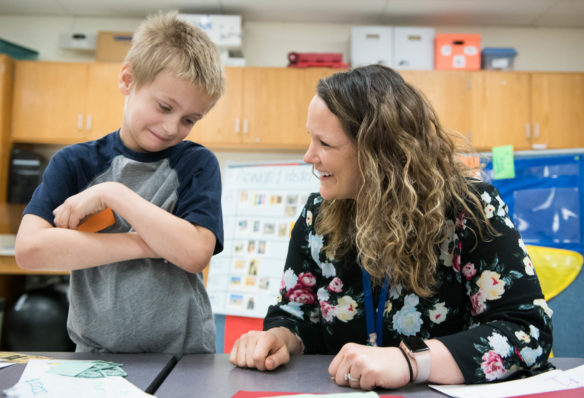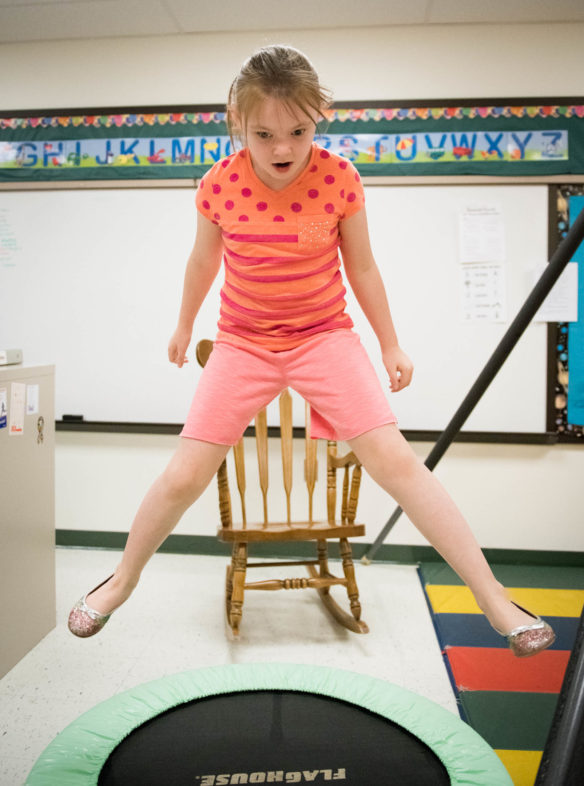
Carter Fretters, a 2nd-grader at Campbell Ridge Elementary School, left, spends “money” that he earned for good behavior. The rewards are part of a small-group focusing on behavior as part of Campbell County Schools’ comprehensive counseling program.
Photo by Bobby Ellis, May 23, 2018
By Brenna R. Kelly
Brenna.kelly@education.ky.gov
When Jessie Martin started as a school counselor at Campbell Ridge Elementary nine years ago, she was the only counselor for 650 students.
“It was very, very challenging,” Martin said. “It was putting out a lot of fires and our office referrals were really high and I was just dealing with the aftermath of behaviors instead of prevention.”
Her guidance curriculum usually had a monthly theme and was not targeted to students’ specific needs, she said.
Today, Martin pulls individual students to a room where they can jump on a trampoline or relax in a swing for a break. She leads small groups based on students’ needs, such as attendance, anxiety or trauma, and she shares the load with one and a half other counselors.
“Now, I feel like we are very strategic. I feel like the whole staff is aware of our goals,” she said. “It is truly a team effort. It’s not just me anymore doing it all; the teachers are on board.”
The change came about six years ago after Campbell County district leaders decided to focus on educating the whole child and adopted the motto “Whatever it takes,” said Connie Pohlgeers, the district’s Director of School Improvement.
“We had focused so much on just academics that we felt it was important that we start to pay attention to the social and emotional well-being of our students,” she said.
To do that, the district decided to revamp the way it provided counseling by implementing the American School Counselor Association’s ASCA National Model, a framework for a comprehensive, data-driven school counseling program.
The framework calls for identifying the skills students will learn in the counseling program, delivering instruction in a systematic way, using data to make decisions, ensuring equitable access to a rigorous education and employing a state-credentialed school counselor.
Each of the district’s seven schools created a counseling advisory board of parents, teachers, Family Resource Center staff, the district’s homeless coordinator and administrators to look at students’ needs and measure the school’s progress in meeting those needs, Pohlgeers said.
“We really wanted to be more intentional with our students and take time to identify their specific needs,” she said. “We only use research-based interventions. We don’t choose interventions to use with our students unless there is a strong research base that supports a positive effect on students.”
Campbell County was one of the first districts to understand that schools have to meet the needs of the whole child in order to improve student achievement and create a healthy workforce, said Robin McCoy, the Kentucky Department of Education’s comprehensive school counseling program coordinator.
“Kentucky school counselors are trained to practice as mental health professionals, unfortunately, for years we have utilized them for clerical tasks and testing coordinators,” McCoy said. “But Kentucky is committed to changing this. Educational leaders are now acknowledging the need for students to have access to comprehensive school counseling services that include academic, career, and social and emotional supports.”
To build a healthy, productive workforce, schools must be intentional about teaching students resiliency, compassion, self and social awareness, and responsible decision making, McCoy said.
“The needs of our students are as diverse today as ever before,” she said. “Schools and districts are now acknowledging the need to be culturally responsive, to build social and emotional learning competencies and to provide supports for students who need additional assistance.”

Summer Santini, a 1st-grader at Campbell Ridge Elementary, jumps on a trampoline during a motor break with Jessie Martin, the school’s student counselor. Santini takes the breaks to so she can use physical activity as a way to vent energy.
Photo by Bobby Ellis, May 23, 2018
To meet the needs of its students, Campbell County used needs assessment tools and with the findings, implemented a three-tiered system for school counseling, similar to Response to Invention.
All students, or tier 1, are taught a guidance curriculum and college and career counseling. At Campbell Ridge, Martin uses Second Step, which includes social emotional learning, bullying prevention and child protection. For students who need more guidance, tier 2 counseling includes small group sessions that focus on topics such as anger management, social skills or chronic absenteeism.
At Campbell Ridge, students spend six weeks in the small group and then graduate if they meet set goals, Martin said.
For students who need more help, tier 3 includes one-on-one counseling and connecting the student with community mental health providers.
In the 2017-18 school year, the district began using a student resiliency poll created by Dr. Rich Gilman from Cincinnati Children’s Hospital to better understand student’s needs.
“With that we have been able to not only identify areas where students need specific attention, but we’ve also been able to identify students with strengths and then hopefully we’ll be able use those peers to help other students develop the same skills,” Pohlgeers said.
In addition to the student self-reported data, the district uses the Measure of Academic Progress Assessments (MAP) data, attendance data and behavior referrals to paint a picture of a student’s overall needs, Pohlgeers said.
The students took the resiliency poll and the MAP tests in the beginning of the year and the end of the school year. The district plans to analyze the resiliency report data and test scores.
“If they met their average growth in reading for the year, and then we see that their anxiety level has decreased, we will know it’s all kind of painting a picture,” she said.
Since the comprehensive counseling program began, behavior referrals have dropped 50 percent across the district, she said. Chronic absenteeism has decreased and test scores in reading and math continue to rise.
“It helps when we look at it as the whole picture, we don’t work in silos,” Pohlgeers said. “We make sure we are all collaborating and working together and I think that really helps, because you can teach reading and math all you want to, but if the child is unstable they are not going to learn it.”
At Campbell Ridge, the changes mean that Martin no longer feels alone on a school counseling island. The teachers also use the Second Step program, which includes empathy, problem solving, how to calm down and skills for learning.
“Everyone is using the same language,” she said. “We all say the same thing about how to calm down. It is truly a team effort. It’s not just me doing it all anymore, the teachers are on board.”
Because the district has become more intentional about its counseling program, Martin now knows which students need to pulled out of class for a break.
“We are doing more preventive, because we are looking at the students’ needs a lot closer,” she said. The school’s behavioral referrals have dropped 70 percent, Martin said.
And everything is tracked by data. Martin never expected to analyze so much data as a school counselor, but now she enjoys seeing the numbers improve.
“I never knew before what kind of impact I was making,” she said. “And now I can see what difference a counselor makes.”
MORE INFO …
Connie Pohlgeers Connie.Pohlgeers@campbell.kyschools.us
Jessie Martin Jessie.Martin@campbell.kyschools.us




Leave A Comment